Introduction to Astronomy
Black Holes
Before we talk about black holes, we need to make a digression into relativity. This is what Einstein is most famous for...
There are two theories of relativity: Special Relativity and General
Relativity. These two theories work together, and revolutionized the
way that we view the world, almost as much as removing the Earth from
the center of the solar system in the 1600s...
Special Relativity:
Special Relativity has two postulates: (a postulate is something
that you assume is true, to see how things turn out. You know if the
postulate is false because it leads to a contradiction later on. But
you never know for SURE if your postulates are correct. Usually we
invent postulates because we have an intuition for how things should
turn out, or because they just make sense.)
- No reference frame is special. This means that the laws of physics
should hold everywhere in the Universe, no matter what speed you are
travelling. So, for example, gravity acts on you whether or not you are
in your car (thankfully!), and while the value of gravity may be
different in different places, such as on the moon, it still works in
the same manner.
- The speed of light, c, is a constant in all
reference frames. This means that if you are travelling in your car at
close to the speed of light, and you turn on the headlights, you will
measure the light travelling at c. So will somebody watching
you drive by! This is completely counter-intuitive. You expect that
when you are travelling at some speed, v, and you throw something at a speed t, it will move away at v+t.
But light doesn't work that way. Instead, it appears bluer when emitted
in the direction you are travelling, and redder when it's emitted in
the opposite direction.
These two postulates have some pretty weird consequences.
First, length is contracted for people traveling at high speed---their
rulers are actually shorter. Also, time is dilated for people traveling
at high speed---their seconds are actually longer. So, you have the
"twin paradox", for example, where one twin gets in a spaceship and
flies away. When they return, they find that they are younger than the
twin who stayed home. Please note that this is not quite the boon it
seems to be. You still live the same number
of seconds---so your heart beats the same number of times, and your
neurons fire the same number of times, as are alloted to you in your
life span. You are just living your life more slowly than everybody
else---you don't get more of it...
We have tested the time dilation consequence, and verified it
experimentally by two methods: First, we synchronized highly accurate
atomic clocks, and put one of them on a high-velocity aircraft. We flew
it around the world a few times, and brought it back to the ground. It
was out of sync. with the clock that stayed on the ground the whole
time. More importantly, it was out of sync. by exactly the right amount
to agree with calculations. Second, we have observed particles called
muons in the lab. These particles don't live very long when we create
them here on Earth. However, we also find them streaming through our
atmosphere at very high velocities, and surviving from the upper
atmosphere, where they are created, all the way to the ground. Because
they are travelling so fast, they live long enough for us to detect
them from the ground!
General Relativity
General Relativity has only one postulate. General relativity says that
gravity is indistinguishable from all other accelerations. So if
gravity is exerting a force on you, it acts upon you in the same way as
if somebody pushes you with the same amount of force. This is neither
intuitive, nor counter-intuitive. It's sort of intuitive, because when
you are in an elevator that accelerates upward, you feel a force acting
on you that seems a lot like gravity, only stronger. On the other hand,
what this implies is that the inertial mass (the property that makes it
hard for people to push on you and get you moving) is the same as the
gravitational mass (the property that the Earth and the Sun and the
Moon use to act on you and on each other). If you think about it for a
while, you'll say 'HEY! That's WEIRD! Why would a resistance to pushing
and a gravitational attraction work in the same way!?!' We have no idea
why this is. We just know that we observe it to be true.
This postulate has one particularly bizarre consequence.
Near really heavy objects, time is distorted: Consider Ted and
Jackie in the accelerating rocket. Jackie is at the back, and Ted is at
the front. They have previously synchronized two flashlights to blink
at the same rate. Now, while they are accelerating, they blink the
flashlights at each other. While the pulses are traveling, Ted is
accelerating away from where Jackie was when she sent the pulse. So the
pulse has to travel further to get to him. He thinks her time has
slowed down. On the other hand, Jackie is accelerating towards where
Ted was when he sent his pulse. The pulse doesn't have to travel so far
to be intercepted by Jackie. She thinks Ted's time has sped up.
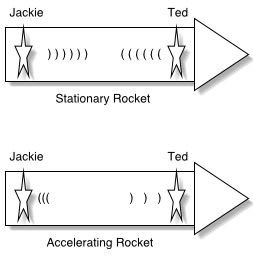 Now, because gravity acts just like any other
acceleration, move the rocket to a massive planet. Ted and Jackie will
observe exactly the same phenomenon, even though they are not moving.
This is called gravitational time dilation.
Now, because gravity acts just like any other
acceleration, move the rocket to a massive planet. Ted and Jackie will
observe exactly the same phenomenon, even though they are not moving.
This is called gravitational time dilation.
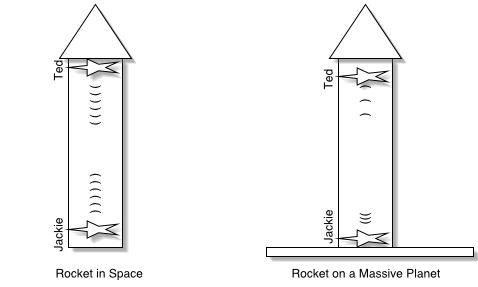 Yes. It's weird. But it follows directly from the postulate, whether or not we like it.
Yes. It's weird. But it follows directly from the postulate, whether or not we like it.
Black Holes
The Earth goes around the Sun. We've got this now as a pretty well
accepted phenomenon. The Moon goes around the Earth. Also a well
accepted phenomenon. At some point, however, you have to ask 'Why?'.
There is no string that attaches the Earth to the Sun, or the Moon to
the Earth. These objects are millions of miles apart, with no physical
connection between them. How does the Earth 'know' that the Sun is
there, so that it can orbit it?! How does the Moon know that the Earth
is here? We always answer this question by saying 'Oh, it's because of
the gravity.' But if you think about it, that's just slapping a name on
your ignorance (not necessarily a bad thing, but not the same as
actually understanding it!).
Prior to Einstein, gravity was thought to be a special thing, that
could act at a distance, just because it could. So the Sun is over there, and it exerts a force on the Earth over here,
just sort of because it wants to. It can act on the Earth from a
distance without having any effect or manifestation in the space in
between.
 Einstein hated
this argument. He did not like the idea of action-at-a-distance---to
him, it was just slapping a name on our ignorance, and then giving up
on trying to understand. He wondered if maybe mass actually affected
its environment (space-time), and that was how gravity worked. This led
to an idea called the "curvature of space-time", and basically it means
that mass bends the space around it. You can imagine this in
two-dimensions as a rubber sheet, with a bowling ball in the middle of
it. From any direction on the sheet, the bowling ball is "downhill",
and other balls placed on the sheet will roll there. If a ball is given
enough energy, however, by rolling it along the sheet, it won't fall
directly in, but will orbit the bowling ball. Trying to imagine this in
three-dimensional space is very difficult, and adding the time
dimension into the mix complicates things even more! But that is the
basic idea.
Now. If Einstein is right, there is at least one observable
consequence. If mass is warping space itself, then even massless things
should be affected by the presence of mass. So, we should be able to
see light bend around a star, galaxy, or other massive object. This was
first tested during a solar eclipse. We took a picture of the night sky
exactly six months before the solar eclipse, and then during the
eclipse, we took a picture of the Sun and the stars behind it. By
comparing the two pictures, it was easy to see that the stars appeared
to move, and were closer to the center of the picture during the
eclipse. It turned out that the amount
that they had moved did not agree with Einstein's theory, but that was
because he'd made a math error, which scientists were then able to
find. This phenomenon is called gravitational lensing,
because it uses gravity to act like a lens and bend light towards a
"focus". The heavier the object in the center, the more space-time is
bent, and the more noticeable the effect.
Let's carry this idea a little further. Suppose the thing in the middle was really
massive, and very small, so that light could pass very close to it,
without hitting it... As you look at light rays that get closer and
closer to the mass, they will bend more and more. At some point, the
light will get bent all the way around the mass, so that it creates an
orbit. This occurs at a particular distance from the mass, and that
distance is called the Schwartzchild radius. The orbit itself is called the event horizon.
Anything that passes closer to the mass than the event horizon will not
escape again. This is a black hole. BLACK HOLES DO NOT "HOOVER" STUFF
UP!!! THEY DON'T PULL STUFF IN!!! THINGS ONLY FALL INTO A BLACK HOLE IF
THEY HAPPEN TO PASS CLOSER THAN THE EVENT HORIZON. Of course, when more
stuff falls in, the black hole gets more massive, and the event horizon
gets bigger. But it doesn't actually suck stuff out of space...
What happens if you fall into a black hole?
Einstein hated
this argument. He did not like the idea of action-at-a-distance---to
him, it was just slapping a name on our ignorance, and then giving up
on trying to understand. He wondered if maybe mass actually affected
its environment (space-time), and that was how gravity worked. This led
to an idea called the "curvature of space-time", and basically it means
that mass bends the space around it. You can imagine this in
two-dimensions as a rubber sheet, with a bowling ball in the middle of
it. From any direction on the sheet, the bowling ball is "downhill",
and other balls placed on the sheet will roll there. If a ball is given
enough energy, however, by rolling it along the sheet, it won't fall
directly in, but will orbit the bowling ball. Trying to imagine this in
three-dimensional space is very difficult, and adding the time
dimension into the mix complicates things even more! But that is the
basic idea.
Now. If Einstein is right, there is at least one observable
consequence. If mass is warping space itself, then even massless things
should be affected by the presence of mass. So, we should be able to
see light bend around a star, galaxy, or other massive object. This was
first tested during a solar eclipse. We took a picture of the night sky
exactly six months before the solar eclipse, and then during the
eclipse, we took a picture of the Sun and the stars behind it. By
comparing the two pictures, it was easy to see that the stars appeared
to move, and were closer to the center of the picture during the
eclipse. It turned out that the amount
that they had moved did not agree with Einstein's theory, but that was
because he'd made a math error, which scientists were then able to
find. This phenomenon is called gravitational lensing,
because it uses gravity to act like a lens and bend light towards a
"focus". The heavier the object in the center, the more space-time is
bent, and the more noticeable the effect.
Let's carry this idea a little further. Suppose the thing in the middle was really
massive, and very small, so that light could pass very close to it,
without hitting it... As you look at light rays that get closer and
closer to the mass, they will bend more and more. At some point, the
light will get bent all the way around the mass, so that it creates an
orbit. This occurs at a particular distance from the mass, and that
distance is called the Schwartzchild radius. The orbit itself is called the event horizon.
Anything that passes closer to the mass than the event horizon will not
escape again. This is a black hole. BLACK HOLES DO NOT "HOOVER" STUFF
UP!!! THEY DON'T PULL STUFF IN!!! THINGS ONLY FALL INTO A BLACK HOLE IF
THEY HAPPEN TO PASS CLOSER THAN THE EVENT HORIZON. Of course, when more
stuff falls in, the black hole gets more massive, and the event horizon
gets bigger. But it doesn't actually suck stuff out of space...
What happens if you fall into a black hole?
Well, aside from the tidal forces, which would stretch you out into
a long thin line and tear you apart and then twist you up into a big
knot (this process is known as spaghettification!)---aside from that,
as you fell into the black hole, not much would happen to you. You
would be travelling, and you'd cross the event horizon, and you'd be
travelling, and everything would be fine. But, because of gravitational
time dilation, someone on the outside would see you slowing down. They
observe your seconds getting longer... You approach the event horizon,
approach the event horizon, keep approaching the event horizon, more
and more slowly all the time, and never quite cross over. Crazy.
Black Hole Evaporation
The Universe spontaneously creates stuff all the time. A
particle and an anti-particle will suddenly come into being. For
example, an electron and a positron will appear where there was
nothing. This is called pair creation. Obviously, this violates all
sorts of laws, conservation of energy being only one of them! If the
particles annihilate each other in a short enough period of time,
however, everything is ok, and the mathematics come out right.
Ordinarily, that's what happens. Pairs are created, then
annihilated---poof. But! Suppose that this happens right next to
an event horizon. One of the pair goes shooting off across the event
horizon, never to return, and his little buddy is left all alone in the
Universe. The black hole then looks like a source of mass, which, if
that mass interacts with something else, may look like a source of
radiation. This radiation is called Hawking radiation after
the guy who thought it up. The energy used to create the particle is
subtracted from the energy in the black hole. Since energy and mass are
interchangeable via E=mc2, the black hole loses mass. This causes the event horizon to shrink.
Now, there are a couple of ways to think about this. The first is
simply observationally. Imagine that you are just outside of the region
where the pair creation happens, so that you view the whole operation
(inside the yellow line) as a single system:
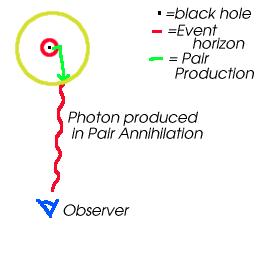
As far as the observer is concerned, light (energy) is coming out
of the black hole. In order for this to balance out, energy must be
removed from inside the yellow line. If all of this happens at the
event horizon, then energy is being removed from the black hole.
But that sounds fishy, right, so let's look at it from another
point of view. Pair creation outside of the event horizon will leave an
'energy hole'. If the particles annihilate immediately, the hole is
filled. But if one zips away, and the other zips into the black hole,
then energy must come from somewhere to fill the hole. One way to think
about it is that the energy is stolen from the gravitational field of
the black hole, making the hole shallower. Thus the black hole
effectively loses mass.
But again, this sounds like it's not quite right. But to get at
what's really happening, we need some quantum mechanics. Usually, we
are used to thinking about particles as having a discrete location. For
example, an electron is AT point x on a line:

But in quantum mechanics, this is not the right way to think about it. Instead, we need to think about particles as having a probability of being in a discrete location.
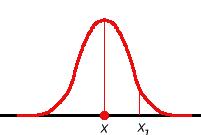
The particle is most likely to be at x, but there is also a small, but non-zero probability that it's at x1 instead. Now, that might seem weird, but it gets weirder. Even if there is a barrier between where you last observed the particle (say, at x), it can still appear at x1, without actually going through the barrier. This is a phenomenon called tunneling, and really happens!
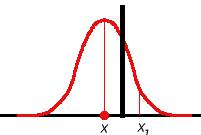
So what does this have to do with our problem? Well, the energy
hole that is left by the pair production actually gets filled by
photons that 'tunnel' out of the black hole. This is the actual mechanism for getting the energy out of the black hole, and thus reducing its mass.
But why doesn't it also sometimes go the other way, with energy
being taken from the Universe by this process, and going into the black
hole?
Because the situation is not really symmetric. The pair creation always happens outside
the black hole. (If it happens inside, none of the particles escape, so
they always annihilate again right away.) So the energy 'hole' is
always made outside the black hole.
The Black Hole Spectrum
If you do the math, it turns out that the spectrum of Hawking radiation is the same
as the blackbody spectrum, so that the black hole looks like a
blackbody of some temperature T. If you calculate this for black holes
of different masses, you find that as the mass of the black hole goes
down, the temperature goes up, and the event horizon shrinks. As the
temperature goes up, the effective luminosity goes up, and the black
hole loses mass faster. Eventually, the black hole no longer has enough
mass to stay a black hole, and it explodes in a burst of gamma rays.
This can take a very long time. For example, a black hole with one
solar mass of material in the center will take 1070 years to
explode. Even in astronomical time scales, this is "forever". However,
little black holes should do this all the time. People claim that they
find these, even claim that they have them trapped in the lab like
little rats, but these claims have never stood up to scrutiny.
What's happening inside?
We don't know! Our laws of physics break down completely! We don't
even have any math for this part of the Universe. Nothing applies here.
Cool, huh? Lots of people are working on this. It's all tied up with
sub-fields of physics and astrophysics like quantum gravity, quantum
field theory, etc., etc.
Have we ever seen one?
Not exactly. We have seen stars in binary systems, where we can
"see" only one star, and it behaves as though it has a companion of a
few solar masses. These systems are also large sources of X-rays,
(which are what happens to that light that gets bent nearly all the way
around the star, and gains lots of energy from the gravity assist).
There are about 1/2 a dozen of these in our galaxy.
Also, we observe the centers of galaxies as huge sources of
X-rays. We can look and see how fast stuff is rotating near the center,
and that helps us to know the density in the very center, and it's too
high to be anything but a black hole (that we know of). So we're pretty
sure that the centers of a lot of galaxies, including our own, are
large black holes.






 Now, because gravity acts just like any other
acceleration, move the rocket to a massive planet. Ted and Jackie will
observe exactly the same phenomenon, even though they are not moving.
This is called gravitational time dilation.
Now, because gravity acts just like any other
acceleration, move the rocket to a massive planet. Ted and Jackie will
observe exactly the same phenomenon, even though they are not moving.
This is called gravitational time dilation.
 Yes. It's weird. But it follows directly from the postulate, whether or not we like it.
Yes. It's weird. But it follows directly from the postulate, whether or not we like it.
 Einstein hated
this argument. He did not like the idea of action-at-a-distance---to
him, it was just slapping a name on our ignorance, and then giving up
on trying to understand. He wondered if maybe mass actually affected
its environment (space-time), and that was how gravity worked. This led
to an idea called the "curvature of space-time", and basically it means
that mass bends the space around it. You can imagine this in
two-dimensions as a rubber sheet, with a bowling ball in the middle of
it. From any direction on the sheet, the bowling ball is "downhill",
and other balls placed on the sheet will roll there. If a ball is given
enough energy, however, by rolling it along the sheet, it won't fall
directly in, but will orbit the bowling ball. Trying to imagine this in
three-dimensional space is very difficult, and adding the time
dimension into the mix complicates things even more! But that is the
basic idea.
Now. If Einstein is right, there is at least one observable
consequence. If mass is warping space itself, then even massless things
should be affected by the presence of mass. So, we should be able to
see light bend around a star, galaxy, or other massive object. This was
first tested during a solar eclipse. We took a picture of the night sky
exactly six months before the solar eclipse, and then during the
eclipse, we took a picture of the Sun and the stars behind it. By
comparing the two pictures, it was easy to see that the stars appeared
to move, and were closer to the center of the picture during the
eclipse. It turned out that the amount
that they had moved did not agree with Einstein's theory, but that was
because he'd made a math error, which scientists were then able to
find. This phenomenon is called gravitational lensing,
because it uses gravity to act like a lens and bend light towards a
"focus". The heavier the object in the center, the more space-time is
bent, and the more noticeable the effect.
Let's carry this idea a little further. Suppose the thing in the middle was really
massive, and very small, so that light could pass very close to it,
without hitting it... As you look at light rays that get closer and
closer to the mass, they will bend more and more. At some point, the
light will get bent all the way around the mass, so that it creates an
orbit. This occurs at a particular distance from the mass, and that
distance is called the Schwartzchild radius. The orbit itself is called the event horizon.
Anything that passes closer to the mass than the event horizon will not
escape again. This is a black hole. BLACK HOLES DO NOT "HOOVER" STUFF
UP!!! THEY DON'T PULL STUFF IN!!! THINGS ONLY FALL INTO A BLACK HOLE IF
THEY HAPPEN TO PASS CLOSER THAN THE EVENT HORIZON. Of course, when more
stuff falls in, the black hole gets more massive, and the event horizon
gets bigger. But it doesn't actually suck stuff out of space...
What happens if you fall into a black hole?
Einstein hated
this argument. He did not like the idea of action-at-a-distance---to
him, it was just slapping a name on our ignorance, and then giving up
on trying to understand. He wondered if maybe mass actually affected
its environment (space-time), and that was how gravity worked. This led
to an idea called the "curvature of space-time", and basically it means
that mass bends the space around it. You can imagine this in
two-dimensions as a rubber sheet, with a bowling ball in the middle of
it. From any direction on the sheet, the bowling ball is "downhill",
and other balls placed on the sheet will roll there. If a ball is given
enough energy, however, by rolling it along the sheet, it won't fall
directly in, but will orbit the bowling ball. Trying to imagine this in
three-dimensional space is very difficult, and adding the time
dimension into the mix complicates things even more! But that is the
basic idea.
Now. If Einstein is right, there is at least one observable
consequence. If mass is warping space itself, then even massless things
should be affected by the presence of mass. So, we should be able to
see light bend around a star, galaxy, or other massive object. This was
first tested during a solar eclipse. We took a picture of the night sky
exactly six months before the solar eclipse, and then during the
eclipse, we took a picture of the Sun and the stars behind it. By
comparing the two pictures, it was easy to see that the stars appeared
to move, and were closer to the center of the picture during the
eclipse. It turned out that the amount
that they had moved did not agree with Einstein's theory, but that was
because he'd made a math error, which scientists were then able to
find. This phenomenon is called gravitational lensing,
because it uses gravity to act like a lens and bend light towards a
"focus". The heavier the object in the center, the more space-time is
bent, and the more noticeable the effect.
Let's carry this idea a little further. Suppose the thing in the middle was really
massive, and very small, so that light could pass very close to it,
without hitting it... As you look at light rays that get closer and
closer to the mass, they will bend more and more. At some point, the
light will get bent all the way around the mass, so that it creates an
orbit. This occurs at a particular distance from the mass, and that
distance is called the Schwartzchild radius. The orbit itself is called the event horizon.
Anything that passes closer to the mass than the event horizon will not
escape again. This is a black hole. BLACK HOLES DO NOT "HOOVER" STUFF
UP!!! THEY DON'T PULL STUFF IN!!! THINGS ONLY FALL INTO A BLACK HOLE IF
THEY HAPPEN TO PASS CLOSER THAN THE EVENT HORIZON. Of course, when more
stuff falls in, the black hole gets more massive, and the event horizon
gets bigger. But it doesn't actually suck stuff out of space...
What happens if you fall into a black hole?


